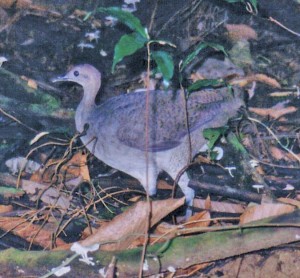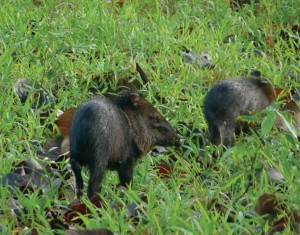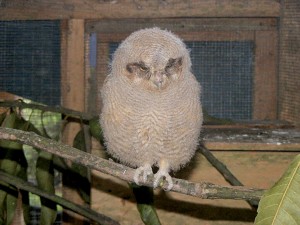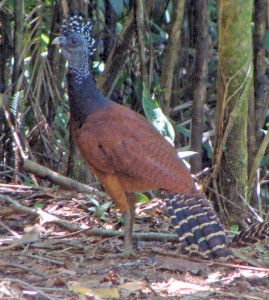Wild Animals are Smarter than We Think
A Glimpse of Intelligence and Adaptability in Tropical Nature
by Jack Ewing

The Jungle Chicken
The great tinamou, called gallina de monte or jungle chicken in Spanish, looks like a grouse. With great effort it can fly, but not far or high. When you are walking through the jungle and a horrible ruckus that scares you out of your wits erupts from the base of nearby tree, it is almost certainly a tinamou. The interesting thing about these chicken-sized, gray colored birds is that they don’t always startle easily. At Hacienda Barú National Wildlife Refuge we discovered years ago that we can use them as a barometer to indicate the prevalence of poachers in the reserve. When lots of illegal hunting is going on the tinamous are very skittish and will take to flight at the slightest provocation. Although the poachers are usually after paca or peccary they will kill the great tinamou as well. On the other hand, after several months without being shot at, they become very tame. I have seen them walking along no more than three of four meters away from people who are hiking through the jungle. What amazes me about this is that the change in their behavior takes place within a short period of time. They apparently learn quickly when people are a threat to them and when not.
Sloth Gossip
I have always been fascinated by the extent to which wild animals can learn and adapt to new situations and opportunities. In Monkeys Are Made of Chocolate I told the story of a mother sloth who discovered a new way of weaning her offspring.
Pochote trees are native to Costa Rica, but not to the southern zone. In 1987 we planted a copse of pochote in an old pasture next to a primary forest. Pochote trees have lots of sharp spines on the trunks and limbs. Sloths love to eat pochote leaves, but must move slowly and carefully through the crowns to avoid the spines.
Weaning an offspring is always a problem for a mother sloth. Since junior doesn’t want to leave mom, she must race, at a sloth’s pace, through the tree tops and put enough distance between them that the baby loses her scent and ceases to follow. This is hard work. One mother sloth discovered an easier way. She carried her weaning aged young into the crown of a pochote tree and left it there. Then she moved completely out of the area. The young sloth, not being as agile as the adult female, took several days to maneuver its way through the spiny limbs until arriving back at the primary forest where it had last been with mom. By that time not even a trace of mother’s scent remained, and the young sloth had to face the cruel world on its own. The amazing thing about this story is that the following year three more mother sloths had learned the same trick. I don’t know how they learned, but it is unlikely that they each learned it independently or that they all observed the female that first discovered the technique. There must have been some communication between them. Sloth gossip I suppose.

Pigs in a Tunnel
When the Highway Department was in the initial stages of the project to construct the final leg of the coastal highway between Quepos and Dominical, we started thinking about the impact that the fast moving traffic would have on the wildlife at Hacienda Barú National Wildlife Refuge. The project managers from the transport ministry were also concerned, and together we began looking for a solution. We came to an agreement that there would be 21 square tunnels under the highway and four bridges over it. For some reason wild animals shy away from round tunnels but don’t have a problem with square or rectangular ones. Both the highway and the tunnels were a new element in the lives of the wildlife, and I must admit that I had my doubts if any animals would use them. To our amazement the collared peccary, wild members of the pig family, began walking through these underpasses even before the construction was completed. We were able to determine this by the peccary tracks entering and leaving the tunnels. About six months after completion of the highway I set up a trail camera in one of the tunnels to find out what other species were using them. In the first five days the camera recorded three different species crossing the highway by way of the tunnel, collared peccary, coatis, and pacas. Large groups of peccary, 20 to 30 individuals, would walk through several times a week. Over the next six months, in addition to those species mentioned above, the camera recorded opossums, agoutis, skunks, raccoons, capuchin monkeys, anteaters, armadillos, tyras, jaguarundis, and ocelots. We have found puma tracks in a couple of the tunnels, but have yet to catch one on camera.
One time one of the cameras captured a video of a female peccary who had recently given birth and whose offspring, about the size of a house cat, was awkwardly following her through the tunnel. Unlike domestic pigs baby peccaries are precocial; they are capable of standing and walking within minutes of being born. This particular baby was struggling to keep up with mom, who was tagging along behind a larger group. Not only was this fascinating to watch, but it brought to light an interesting reality. For this baby peccary, only a few hours old, tunnels are part of the natural environment, and the same is true for all peccaries born after the construction of the tunnels in 2010. In one generation the behavior of crossing under the highway has become completely ingrained in the minds of the collared peccaries at Hacienda Barú. It is no longer something recently learned, rather it is just part of life.

The House Owl
Some of you long time readers may remember the story of Iggy, a tropical screech owl who my wife, Diane, raised since he was nothing more than a ball of fluff. Diane taught him to catch and kill live mice and patiently put him through a process of learning how to survive in the wild. Eventually she released him into the wild, but for Iggy, our house was part of the natural environment. He loved to fly around our living room and hunt crickets. The second year of his life he mated and over the years has raised so many young that I have lost count. Iggy still visits us occasionally usually accompanied by at least one other owl. Since he was raised inside of a human dwelling, he has no fear of humans or their buildings, and he has taught this behavior to other owls. Other homes in the area have reported owls coming inside to capture and eat crickets and other large insects. At this time there are five generations of owls who no longer see human habitations as a threat. For those of you who would like to read more about Iggy you can find the entire story at: www.haciendabaru.com/a-ball-of-fluff-called-equinox/

The Great Curassow
Called pavón, meaning big turkey in Spanish, the great curassow is the largest bird in Costa Rica with the possible exception of the harpy eagle, whose existence in the country is doubtful. In the year 1999 a study was done of the area covered by the Path of the Tapir Biological Corridor to determine if there was enough biodiversity to merit the expenditure of large sums of money and human effort that would be necessary to carry the project to completion. A dozen different biologists, each a specialist, surveyed the corridor and reported on the diversity of species within their own field of expertise. This included everything from fish and insects to amphibians and mammals. One of the most renowned ornithologists in the country carried out the study of birds. Upon the completion of the study the biologists met with the local people who lived in the area covered by the biological corridor. Some biologists listened carefully to the local people and evaluated the information gleaned from them. The ornithologist, on the other hand, totally disregarded any information emanating from local sources. Try as we might, we couldn’t convince him that there were great curassows in this region. He didn’t see one during his survey, so in his mind they didn’t exist here. Fortunately the biologist in charge of the study was more inclined to accept local knowledge. Not only was the pavón included in the list, it was designated as an indicator species. This is a species whose presence and estimated abundance serves as an indicator of the overall biological health of the area. The reasons it was named an indicator species was because it is supposedly found exclusively in primary forest, and it tends avoid all encounters with humans. At Hacienda Barú National Wildlife Refuge the hilly portion of the reserve is covered with primary forest and the lowlands with secondary forest. So according to the above criteria the great curassow should not be found in the lowlands of Hacienda Barú. To everyone’s surprise within a year visitors, guides, and park rangers began reporting sightings in the lowlands. Today we estimate that there are a dozen mated pairs within the secondary forests of the lowlands. Not only that, but they have become so tame that they pay little attention of visitors on the trails.
Anyone who lives near a rainforest and/or spends time hiking through one has surely witnessed similar examples of learned behavior in wild animals. More years ago than I like to remember my high school science teacher told us that all animal behavior was governed by instinct, and that wild animals don’t learn from their environment. Today few scientists or naturalists still hold that erroneous view.

